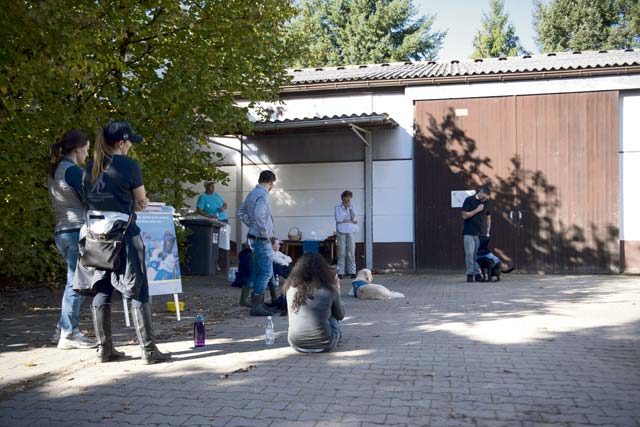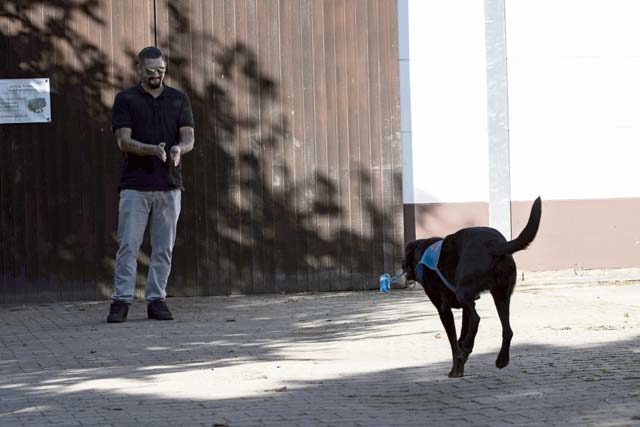
He said going out in public gave him a feeling of unease. He would leave his home to return back to it in a state of panic. This occurred for nearly five years, until Richard met Abby. She was different; she could read him like a book. If he started panicking, she could calm him in down in a matter of moments. But Abby isn’t a human; Abby is a service dog, and for people with service dogs, the age-old saying, “man’s best friend,” has never been more true.
After a deployment in the Middle East, two U.S. Army veterans returned with post-traumatic stress disorder. After attempting to combat the effects of PTSD with traditional medication, the vets found a curious medicinal cure in the form of a furry partner.
“I didn’t care about people,” said Richard Rice, U.S. Army veteran with PTSD and partner of service dog Abby. “I was really closed off to the world. I was seeing a lot of doctors, taking a lot of medication, and nothing was helping. “
Rice explained that he was consciously paralyzed after he was injured by an improvised explosive device while on his deployment. He said the doctor, who was also a fellow Soldier, made a mistake but didn’t apologize for his actions.
“I lost trust and empathy with people,” Rice said. “I wasn’t good at showing emotions.”
Rice’s wife decided to move back to Germany, and he followed her. Shortly after, Rice and his wife decided he needed help and got involved with the service dog organization. Rice said one of the most important things to understand about service dogs is that they are not robots.
“It took me about a year working with Abby before I came to the realization that a service dog can help me,” Rice said. “For a long time, I was very hypervigilant. I was always lost in my head, and I was always panicking and always fearful. But there was this one time I was working with Abby, and I was just completely lost in the moment, and I was so excited. I made eye contact with her, and she sat and looked up at me. I had this release in my head where I felt free, and I became addicted to that release. So I kept coming back for more and more. When I got paired with Abby, I found out that I didn’t need to take medication anymore.”
Rice said that when he doesn’t have a good feeling, he can concentrate and lose himself in Abby’s eyes instead of having to take anti-anxiety medication. He said it completely calms him down, and he can do it as many times as he needs to with no negative side effects.
“It’s a positive thing,” Rice said. “It’s positive for myself, the people around me, and it really brings me down. That just one thing she does for me that is really special.”
A few years later, word of Rice’s success story made it to a fellow U.S. Army veteran with PTSD. After an exchange of emails, the two gentlemen discovered they had a lot more in common than they initially thought.
Chris Holland, a U.S. Army veteran with PTSD, served with Rice at the same deployed location at the same time, but they never met until then. The two instantly knew how the other felt, and Holland was entered into the program to receive a service dog.
Holland worked with the program for months before he was paired with service dog Pepper.
“The dog has to grow with you and grow as a team,” Holland said. “He’s a dog like every other dog, and all dogs react differently, like we react differently.”
He said his favorite thing about dogs is that they never lie to the person. He explained that Pepper often looks like he’s just being lazy, but in reality, he’s doing his job. He said that if Pepper is relaxed, it means there isn’t anything to worry about.
“PTSD dogs are more intellectually sound with their team members,” Holland said. “They help more than what people see. It’s hard to explain what my dog does for me. They give you security; they let you know they’re there. It also builds you as a character to where you want to be. You may never go back to your original self or maybe you don’t want to, but they’ll put you in a better place than you were before.”
Holland says he thinks he is headed to a better place and will always be making progress. He believes others will also be able to find a way forward if they find the right tools like he has found in his service dog.
Editor’s note: This is a two-part series. In the first part, read about the process for a dog to be selected and trained as a service dog at http://www.ramstein.af.mil/News/Article-Display/Article/1355601/service-dogs-not-your-average-household-pet.



